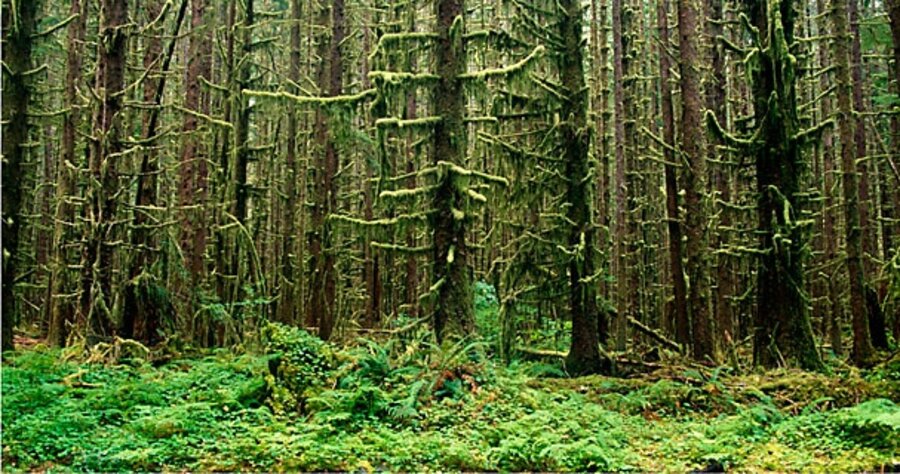US forests hold new evidence of global warming
Loading...
Old-growth forests in the Western United States appear to be losing ground to the regional effects of global warming.
That’s the conclusion a team of federal and university-based forest ecologists have reached after looking at long-term trends in patches of relatively pristine old-growth forests. The study sites range from northern Arizona and north central Colorado to the Olympic Peninsula and southern British Columbia.
Over the past 50 years, trees large and small in these tracts – largely untouched by wildfires or beetle infestations – have been dying at an increasing rate. And the rate at which they are being replaced has not changed. If the trend continues, researchers say, forest age, average tree size, and carbon-storing capacity of these areas will gradually fall.
After examining a range of possible causes for the region-wide pattern, the last ones standing are the West’s warming trend and warming’s effect on the amount of water these areas receive. Summer dry spells are longer. Snows melt earlier. More winter precipitation falls as rain, rather than snow, and the snow that falls has a lower water content than it once did.
More trees are dying
“Tree death rates have more than doubled in old-growth forests across the western United States” during the study period, says Phillip van Mantgem, an ecologist with the US Geological Survey’s Western Ecological Research Center in Three Rivers, Calif. The rising mortality rates spanned a range of elevations, species, and tree sizes, he continues.
“If these trends continue, forests will grow sparser over time,” says Dr. van Mantgem. And while he acknowledges that the results come from a relatively limited number of one- to two-acre plots, “our results imply that these trends could be occurring on a much broader scale.”
The team looked at data from 76 undisturbed patches of forest averaging some 450 years old. Some tracts were more than 1,000 years old.
The study represents the most exhaustive yet for this geographic range of temperate forests, notes Andrew Sugden, a botanist and international managing editor for the journal Science, which published the results in Friday’s issue.
Until now, many forest studies have looked at the role wildfires and beetle infestations have had on western forests. Others have looked at the way species are beginning to move to higher elevations. Each of these is related to warming.
But as devastating as they are, beetle infestations and wildfires are episodic catastrophic events. Despite the high profile they get, most forests appear for now to be relatively healthy, the team notes. And species migration would appear to allow for the species’ continued survival, as long as they don’t run out of higher elevations to reach.
The long-term trends in this study, however, suggest that warming is affecting the underlying demographics of the tracts the research team studied.
The results run counter to trends seen in the tropics. In undisturbed tracts there, tree mortality and replacement both are increasing.
The study adds to a growing body of research that suggests any country with extensive forests – whether tropical, temperate, or boreal – may deserve a place at the table when global climate talks discuss “avoided deforestation” as a tool for reducing greenhouse-gas emissions.
So far, the approach has been seen largely as a way to encourage developing countries with extensive tropical forests to take part in a new global climate treaty. But last September, an international team of scientists led by Sebastiaan Luyssaert at the University of Antwerp in Belgium, published a study showing that globally, old-growth forests outside the tropics actively soak up and store carbon dioxide from the atmosphere far longer than previous estimates had indicated. [Editor's note: The original version misstated the location of the University of Antwerp.]
Indeed, for many of the tree species in the latest study, the likelihood that a tree will survive for another year increases, rather than decreases, with time, notes Jerry Franklin, a forest ecologist at the University of Washington in Seattle.
“One of the things that absolutely should be on the table in any global carbon agreement is the notion of avoided carbon releases,” Dr. Franklin says. “Old forests have very large accumulations of carbon in them.” If these forests are felled, it will lead to significant carbon emissions over the short and medium terms – emissions that can’t be recouped by turning the wood into lumber or by planting replacement trees, he says.
Housing development could be affected
If the trends continue, they have implications for the region’s efforts to adapt to climate change, adds Thomas Veblen, a biogeographer at the University of Colorado at Boulder. Particularly when the underlying die-off is accelerated by insect infestations, wildfire managers will have to rethink their strategies for reducing wildfire risks, including current policies that encourage people to build large housing developments in wildfire-prone areas.
In addition, the changes are making wildlife conservation efforts more difficult to plan.
Often, conservationists set a target by learning what an area was like in the distant past, then they try to re-create that, says Nathan Stephenson, also with the USGS research center in Three Rivers, Calif. “As climate changes and other environmental changes happen, the past may no longer be the best model for the future. We may switch from trying to keep a snapshot of the past to efforts to help guide things into the future while sustaining old forests.”
For Franklin, even that may be too gentle. “So much of conservation is focused on going back or keeping it as it is,” he says. Faced with a warming climate, “you can’t go home.”





